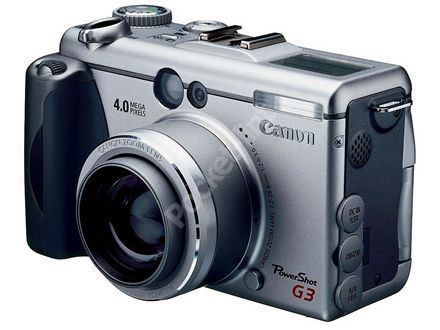Canon’s G3 announced at Photokina 2002, caused many to believe that Canon had shot too low with its high-end compact digital camera offering. Some nine months later and the camera has already been superseded by a five million pixel version.
Our quick take
Overall the Canon G3 is a very good camera only marred by its size. Image quality was good both up-close and landscape (see deer right). Of course this has now been superseded by the G5, but if you aren't fussed with the option of a longer digital zoom and extra mega pixel then this camera certainly gives you plenty of manoeuvrability over its settings.

Canon Powershot G3 - 4.0 / 5
| FOR | AGAINST |
|---|---|
|
|
To reflect the fact that the camera has now been knocked off its top spot, Canon has cut the price from £600 and this now makes it a very attractive purchase indeed.
A four mega pixel camera with a 1/1.8” CCD sensor the G3 is a rather large camera that is sturdy to use but awkward if you are hoping to pocket it at anytime. The large 1.8” LCD display is mounted on a vari-angle bracket that allows it to be fully rotated to allow for shooting at various heights and levels. The bracket also ensures that your LCD display won’t be scratched when carried around as the bracket closes to protect the screen.
The camera features plenty of quick access buttons all positioned on the rear of the camera. The main program selector wheel is located on the top of the camera and this allows you to easily change between camera modes - all 12 of them. For the traditional 35mm camera fans the camera also has the traditional viewfinder with dioptre correction.
Picture settings are displayed either on the LCD display or via a separate display on the top of the camera giving you an uncluttered view of the shot in hand. This is also great if you want to see what settings the camera has selected without relying on the back display.
Those looking for even greater control over their images can use the hotshoe connection for control over their flash settings. The camera does offer an internal flash with three manual power adjustment settings and four flash modes including Red-eye reduction and Slow Sync Speed.
Inside, the camera offers 4.0 mega pixels (2,308 x 1,712) and a zoom length equivalent of 35 - 140mm in a 35mm camera. Add this to the 3.6x digital zoom and you’ve got 14x zoom overall. As we say with all Canon cameras the digital zoom shouldn’t be relied upon, but it is there to get you out of trouble.
Focusing and metering your shots can be done in a number of ways - TTL 1-point (any position is available or fixed centre) AF lock and Focus Bracketing offer the focusing options, while spot metering and AE lock are available with ISO speed settings of 50 - 400.
While everything can be manually changed, and with this sort of camera that is likely to be the case, there are 13 shooting modes to chose from to get you going. These include everything from Automatic to Night Scene, Stitch Assist and Movie mode.
Images can be stored in a number of different formats to get more out of the 32Mb card shipped in the box. At the highest setting you’ll have a mere 14 shots before you run out of space, but at the other end you’ll be able to achieve a massive 337 images although this is at the lowest setting.
As with most Canon cameras the image quality is very good. The response time from pressing the button to taking the shot was very quick allowed for easy capture of action shots. Images taken with the Canon G3 were crisp and sharp, even at night using the flash. The macro mode was especially good allowing us to get very close to the subject (see text image right). When we tested the pictures at night the flash modes coped very well, if the LCD display didn’t. Images were prone to over exposing when in Auto mode, but this could be fixed with the flash settings.
To recap
The results are worth lugging this rather big model around. Being usurped by 1Mp on another model makes this cheaper on the street- so shortlist it.
